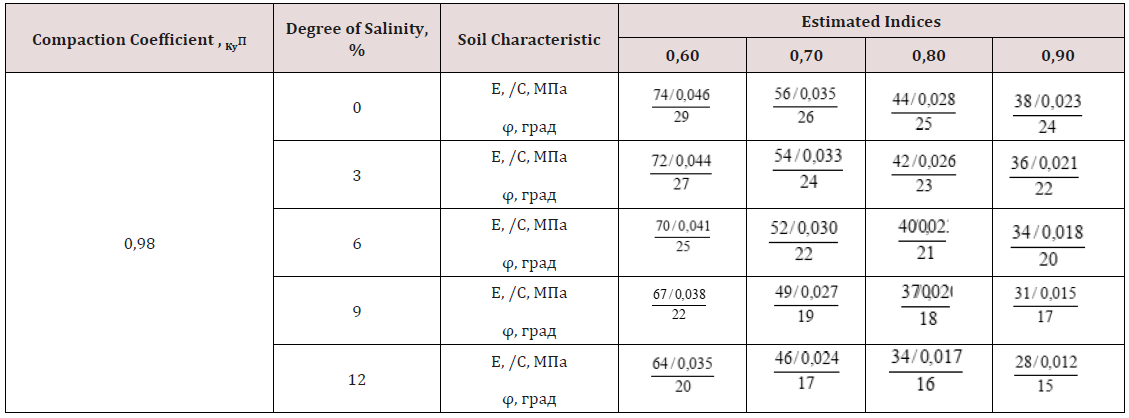
Lupine Publishers Group
Lupine Publishers
Menu
ISSN: 2637-4668
Research Article(ISSN: 2637-4668) 
Substantiation of Design Characteristics of Saline Soils of The Subgrade Embankments Volume 3 - Issue 4
Qayumov Abduboqiy and Hudaykulov Rashidbek*
- Tashkent Institute of Design, Uzbekistan
Received: June 12, 2019; Published: August 30, 2019
Corresponding author: Hudaykulov Rashidbek, Tashkent Institute of Design, Construction and Maintenance of Automotive Roads, Uzbekistan
DOI: 10.32474/TCEIA.2019.03.000169
Summary
An improvement, strength and deformation characteristics of saline loess soils are discussed in the paper. Using the results of laboratory tests in field conditions, a recommendation has been developed on the use of stabilizers to improve the properties of loess soils used in calculation of road pavements design. Studies have been conducted to substantiate the design characteristics of the working layer of the subgrade built of saline soils with account of hydro-thermal regime; the development of design solutions; the improvement of the methods for determining humidity and functional dependencies based on the determination of their indices; the improvement of saline soils properties; the development of stabilizing surfactants “Bitumen emulsions”
Keywords: Saline soil; Stabilization; Water resistance; Bitumen emulsions; Surfactants; Loess soils; Compressive strength; Flexural strength
Introduction
The problem of saline soils usage in design and construction of roads is of great importance. Saline soils are widely distributed along the coasts of the Pacific, Atlantic, Indian oceans and the majority of seas. As a foundation of the structure, saline soils are used in Australia, Egypt, India, Iran, Kazakhstan, Mexico, Pakistan, Russia, the United States, Uzbekistan, and in several European countries. Therefore, the study of the properties of saline soils, including the stability assessment of road embankments built of saline soils is considered an urgent task [1]. In the process of design, building and operating of highway roads scientifically based and targeted studies of the strength characteristics of saline soils in the body of the roadbed are relevant all over the world. The most actual issues in these spheres (including the substantiation of their design characteristics) are the following ones: the development of design solutions for the working layer of the roadbed of saline soil; an account the hydro-thermal regime; the improvement of the methods to assess the density and moisture content; the properties of saline soils of the roadbed of existing highway systems; the substantiation of design characteristics of saline soils; the improvement of the methods for artificial improvement of the properties of saline soils with surfactants; the development of the methods for predicting their effect on design characteristics of the roadbed [2].
Currently, in the transport and communication system of the republic, a special attention is paid to the qualitative improvement of the design, construction and operation of roads. To fulfill these tasks the following aspects should be implemented: the substantiation of design characteristics of the working layer of the roadbed of saline soils, taking into account its hydro-thermal regime; the development of design solutions; the improvement of the methods for determining the moisture content and functional dependences on the basis of determining their parameters; the improvement of the properties of salinized soils, the development of stabilizing “Bitumen emulsion” surfactants. In this direction due to improvement of the methods of increasing the strength of the subgrade layers, i.e. taking into account the transport loads, the construction of new highways and the development of calculation methods to reduce the turnaround time of their operation are considered as urgent tasks.
Method of Researches
Considering the features of the use of saline soils in the roadbed and road pavement, the following types of salinization are distinguished: chloride, sulfate-chloride, chloride-sulfate, sulfate and soda, and the following degrees of soil salinity: slightly saline, moderately saline, heavily saline and excessively saline soils. In different regions of Uzbekistan in different natural conditions, saline soils differ both in composition and quantity. The salts most commonly found in soil structure are: NaCL, Na2SO4·10Н2O, МgSO4·7Н2O, МgCL2·6Н2O, CaCL2·6Н2O, NaНCO3, Na2CO3·10Н2O, CaCO3 and CaSO4·2Н2O [3]. Irrigated lands make up 1970,700 hectares, of which 50% of irrigated land falls in newly acquired areas. Including 75% of the land in some different levels of salinity, including weak salinity of 1117.7 thousand hectares, average salinity - 611.2 thousand ha, strong salinity - 241.6 thousand hectares [4].
Allowable salt content in sub grade soils determined with the amount, which is soluble in water, filling the pores of the soil, compacted at optimum moisture. Classification of saline soils for using of road works [5] is in under given Table 1. The degree of soil salinity at the base of the roads and its influence on the estimated indices, physicomechanical properties of roads have been comprehensively studied by foreign scientists: Braja MD, David GP, Kuhn W, Neal BG by the researchers from the CIS countries: VF Babkov, VM Bezruk, Bartolomey IL, Groth AI, Jerusalemskaya MF, Karpov BN, Karpushko MO, Kuznetsov YuV, Kulizhnikov AM, Likov VA, Motylev Yu L, Mordovich SS, Naletova NS, Olkhovikov VM, Rogovskaya NV, Sergeev EM, Sidenko VM, Sukhorukov AV, Ushakov VV , Shulgina VP, by the scientists from Uzbekistan: Babakhanov PB, Ilyosov N, Kalandarov TK, KayumovAD, Rozhdestvensky ED, Rasulov KhZ, Stupakova LF, Khasanov AZ and others [1].
The analyzed factors affecting the estimated indices of saline soils in the estimated period, and determining their difference from the values given in Normative Standards of Construction 46-08 [6], can be the following:
I. The features of saline soils in comparison with clay soils of
the same content, first of all, the content in composition of
different salts in different amounts;
II. The probability of a difference in density values of saline
soils determined in field conditions from the ones given in
Normative Standards of Construction 46-08;
III. The probability of a difference in design of the working layer of
the roadbed of existing roads built on saline soil from the ones
given in the regulatory documents on design.
Figure 1: Design scheme of constructive solutions of road embankment, where: W1 is the initial humidity equal to the optimum humidity under soil compaction of the road bed,%; Wрас is the calculated humidity,%; Wтек is the humidity under soil yield,%; Zа is the active zone, m; hР is the distance from the groundwater level to ground line surface, m; hВ is the distance from the ground water level to the pavement design bottom, m; hБ - is the distance from the ground to the edge of the road bed, m; HO is the pavement thickness; nO is the width of the curb, m; i is the slope of the curb; GWL is the groundwater level.

Thus, we may conclude that the calculated indices of saline soils in the roadbed depend on the type and amount of salts. For this reason, to determine the permissible values of the indices, it is important to conduct research in different regions of Uzbekistan and, in parallel, in laboratory conditions. The soils of the working layers of road embankment are in a stressed state under the effect of loads caused by vehicles and under the influence of hydrothermal regimes. Studies of the water regime of the subgrade in irrigated areas have shown that the field irrigation regime and the ground waters are the sources of wetting of the working layers of the road [7]. Based on the above considerations, to determine the estimated indices of road embankments built from saline soils in the conditions of Uzbekistan, the following scheme was proposed (Figure 1). In the diagram, the boundary of the active working layer is located at a certain depth from the pavement surface and at a certain height from the groundwater level. Ground water along the capillaries rise up and moisten the soil. The groundwater level changes with time, and the capillary diameter changes accordingly. Analysis of the constructive solution presented in Figure 1 shows that the strength and deformation indices of saline soils used in design of the pavement depend on its density, humidity, type and amount of salts. This functional dependency can be written as follows:

Where: КуП is the soil compaction factor; Wрас is the calculated moisture, relative to the moisture at the yield point; N is the degree of salinity; A is the type of salts.
In these expressions (1), we first need to determine Wрас and Куп. In accordance with the goal of the research in laboratory and field conditions, it is necessary to investigate the effect of the indices given in the functional dependence (1) КуП, Wрас, N, А on indices Е, С, φ separately and as a set.
Discussion of Received Information’s
Researches carried out by VM Bezruk, YuL Motylev, LF Stupakova show that in natural conditions of Uzbekistan soils are often strongly or excessively saline by sulphates and chloride -sulphates. Therefore, we have conducted the studies in laboratory conditions with soils, artificially salted by chlorides (NaCL), sulphates (Na2SO4·10Н2O, МgSO4·7Н2O) at a concentration of 1-12%; salts of crystalline gypsum (CaSO4·2Н2O) at a concentration of 10-15%. For the study, two types of non-saline loess soil samples from the area of 16-20km of the 4Р1ring road of Tashkent have been selected. In terms of the amount of easily soluble salts, the soil under consideration belongs to slightly saline soils. The granulometric composition of soil is determined by preliminary washing with a sieve and a pipette. Soil samples for research have been prepared in the following order: light or heavy sandy loam, dried in air, is crushed and ran through a sieve mesh of 1mm, then, water solution with various salts of different concentrations is added in a required amount. This soil sample is stored in an exsiccator for three days, then drained in air and passed through the same sieve. Based on the aims of the study, soil passed through a sieve, is brought up to the desired humidity and density. Studies in the field conditions have shown that the soils of road base are mainly sandy heavy pulverescent loam. For this reason, laboratory studies have been conducted on saline heavy, pulverescent sandy loams. Soil samples are moistened to (0.60; 0.70; 0.80; 0.90) Wтек and compacted in metal rings with a diameter of 7.1cm and a height of 3.5cm to a density of 0.94; 0.96; 0.98; 1.00; 1.02. Then, the soil sample together with the ring is installed on the Maslov- Lurie device and the indices of cohesion C and internal friction angle φ are determined. A sample of saline soil was prepared in a similar order in a metal ring with a diameter of 10cm and a height of 11cm. The soil was compacted to the required value and the elastic modulus Е was determined, using a punch with a diameter of 3cm and a lever installation. Figures 2-4 show the results of a study carried out to determine the dependence of the modulus of elasticity, cohesion force and the angle of internal friction of saline soil with chloride (NaCL), sulphates (Na2SO4·10Н2O) and gypsums in the form of a crystal (CaSO4·2Н2O) with different humidity (0.60 ; 0.70; 0.80; 0.90 Wтек) and density (compaction factor is 0.94; 0.96; 0.98; 1.00; 1.02).
Figure 2: Graph of dependence of elasticity modulus of NaCL saline soil on the amount of salinity and humidity: КуП=1,00; 1-0,60Wтек; 2-0,70Wтек; 3-0,80Wтек; 4-0,90Wтек.
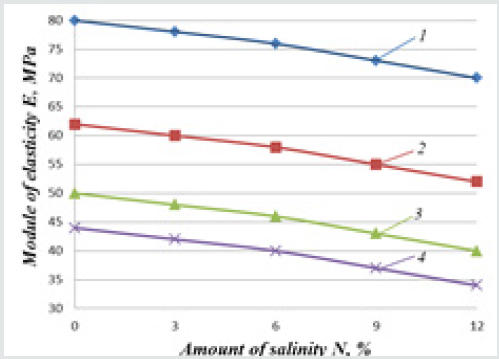
Figure 3: Graph of the dependence of the angle of internal friction of NaCL saline soil on the amount of salinity and humidity: КуП=1,00; 1-0,60Wтек; 2-0,70Wтек;3-0,80Wтек;4-0,90Wтек

Figure 4: Graph of dependence of specific cohesion of NaCL saline soil on the amount of salinity and humidity: КуП = 1.00; 1-N = 0%; 2-N = 3%; 3-N = 6%; 4-N = 9%; 5-N = 12%
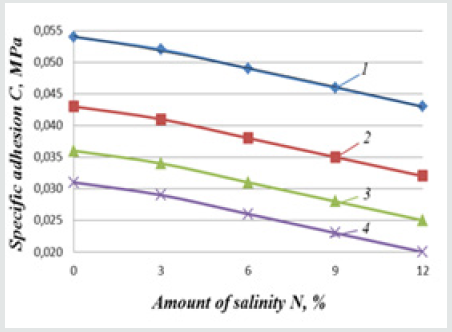
Based on the planning of experiments, we tried to obtain mathematically regressive dependencies characterizing the changes in the calculated indices of the sulfate and chloridesulphate (SCS) and chloride and sulphate-chloride (CSC) soils, depending on: compaction factor Х1-КуП; the estimated humidity Х2-Wрас and the degree of salinity of Х3-N chloride:
For sulfate and chloride-sulfate saline soils:
Elasticity modulus

The angle of internal friction:

Specific cohesion:

For chloride and sulfate chloride saline soils:
Elasticity modulus:

The angle of internal friction:

Specific cohesion:

Studies have been carried out to identify the estimated indices of artificial saline soils stabilized by “Bitumen emulsion” under laboratory conditions, and in field conditions in the Fergana region on the 4P - 126 road “Balikchi k, Mingbulok k, Naiman k, Pungon k” (Figure 5). Maslov-Lurie lever device and single-plane shear have been used in soil testing.
From the research results shown in Table 2, it was found that with a compaction ratio for stabilized soil, the elasticity modulus increases up to 89 MPa, that is, it increases by 12%; the cohesion force - up to 0,054 MPa, that is increases by 15%; angle of internal friction -by 29 degrees, that is, increases by about 10%. According to the results of field tests, we can recommend the compaction ratio Куп of soil for road embankments, achieved by the existing compacting machines acting along the height, (Table 3-5).
Figure 5: On the highway 4P - 126 4P - 126 road “Balikchi k. - Mingbulok k. - Naiman k. - Pungon k.” Used single-plane slice used for testing soils.
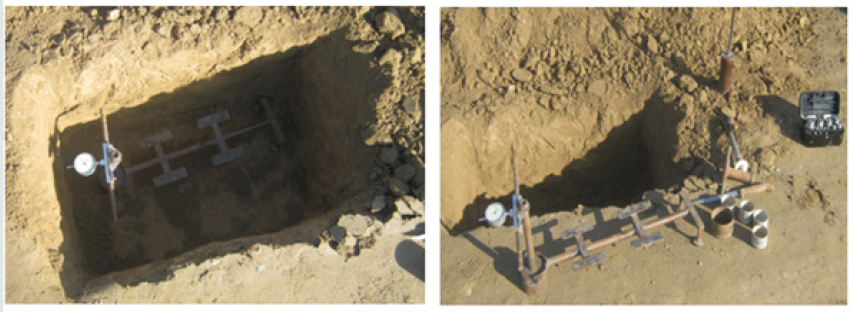
Table 2: Estimated values of artificially salted pulverescent light sandy loams stabilized and unstabilized by “Bitumen emulsion”.

Under field conditions, the modulus of elasticity of saline soils is determined using a lever press. Indices of the angle of internal friction φ and cohesion force С of saline soil samples taken from experimental site and existing roads have been determined using a device of a single-plane rotatory shear. The calculated indices of saline soils determined in field and laboratory conditions are summarized and given in Tables 6-8 for sulphate- and chloridesulphate salinity, and chloride-and sulphate-chloride salinity (Куп = 0.98), respectively.
Table 8: Coefficients taking into account the humidity, degree of salinity and soil compaction.

Note: numerator - sulphate- and chloride-sulphate saline soils; denominator - chloride- and sulphate-chlorid saline soils.
To calculate the thickness of the pavement in field or laboratory conditions, the estimated humidity, the compaction ratio, the type of salinity is determined, and then using formulas (2) and (7) E is calculated. However, it is inconvenient to use these formulas, since E is given for discrete values (N = 0, 3, 6, 9, and 12), the compaction coefficient (Куп = 0.94; 0.96; 0.98; 1.00 and 1.02); the estimated humidity (Wрас = 0.60; 0.70; 0.80 and 0.90Wтек). In design practice, intermediate values are often used. Therefore, to accurately determine the dependence of E, C, φ on other indices, we managed to develop an analytical expression for saline soils.
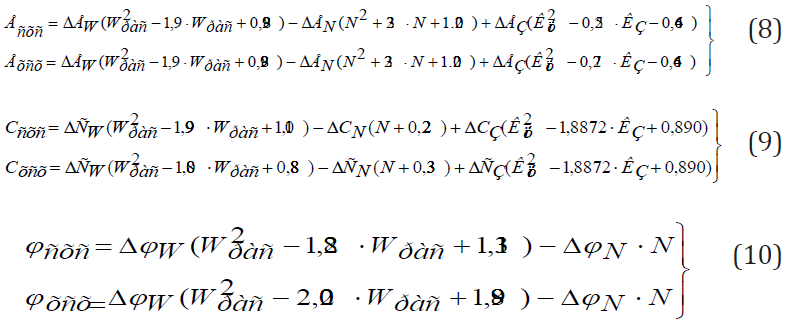
Where: ΔЕ W, Δ ЕN, ΔЕЗ, ΔСW, ΔСN, ΔСЗ, ΔφW and ΔφN - due to coefficient taking into account humidity, the stage of salinity, coefficient of soil packing, values which are given in Table 8.
To determine the degree of accuracy (reliability) of the expressions (8-10) obtained, the variances of inadequacy and “Reproducibility” have been defined. The correlation coefficient for the above cases is R = 0.97. This means that the derived formulas sufficiently well reflect the ongoing processes. Thus, the type of salinity and the amount of salt in soils affect the estimated values of the modulus of elasticity E, cohesion force C and the angle of internal friction φ of the subgrade soil. Their values can be determined by formulas (8-10) depending on the quantity and quality of salinity.
Conclusion
A. To predict the design characteristics of road embankments
built of saline soils a design solution - a scheme of the working
layer wetted by capillary water is proposed. This allows one
to obtain functional dependencies for setting the estimated
characteristics of the working layer of the subgrade during its
design.
B. Design characteristics of the working layer of the subgrade of
the existing roads are determined and differentiated according
to the quantity and quality of salts, the density and humidity of
saline soil. This allows one to create optimal pavement designs.
C. In the field conditions, to determine the strength of compacted
soils, the existing single -plane portable devices have been
improved and tested in actual conditions. This allows one to
quickly determine the strength characteristics of saline soils.
D. As a result of the study, some changes in the indices of saline
soils have been introduced to existing regulatory documents.
These changes allow a 15% increase in the use of highly saline
soils considered unsuitable for road construction.
To improve the physicochemical and physicomechanical properties of saline soils, a “bitumen emulsion” surfactant has been developed; in the “Saline Soil+Bitumen Emulsion” system, the designs of road embankments built of saline soils have been proposed. This allows increasing the strength and stability, reducing the height of the embankment and increasing the service life of the roadbed.
References
- Hudaykulov RM (2018) Substantiation of calculated characteristics of embankments of earthen cloth from saline soils. Thesis for the degree of Doctor of Philosophy (PhD) in technical sciences. Tashkent, Uzbekistan, p. 133.
- Hudaykulov RM (2016) Calculated characteristics of saline soils used in transport construction. Metro and tunnels - Moscow, Russia, 1: 32-36.
- Kayumov AD, Agzamov IA, Hudaykulov RM (2013) The saline soil road upper. Tashkent, Uzbekistan, pp. 130.
- Hdaykulov RM (2014) Analysis of sources of saline soils on automobile roads. Information of the Tashkent State Technical University, Tashkent, Uzbekistan, pp. 221-225.
- (2014) Scientific and technical report on “Assesing the impact of watersalt regime of soil on the basis of transport facilities and development of sustainable constructions in Uzbekistan”. Tashkent Automobile Roads Institute (TARI), Tashkent, Uzbekistan, pp. 154.
- (2008) Normative Standards of Construction 44-2008. Elastic road of bedding design guidelines. Tashkent, Uzbekistan, pp. 244.
- Neal BG (2013) The Design of Piled Foundations and Edition. Structures and Solid Body Mechanics. p. 35-42.

Top Editors
-

Mark E Smith
Bio chemistry
University of Texas Medical Branch, USA -

Lawrence A Presley
Department of Criminal Justice
Liberty University, USA -

Thomas W Miller
Department of Psychiatry
University of Kentucky, USA -

Gjumrakch Aliev
Department of Medicine
Gally International Biomedical Research & Consulting LLC, USA -

Christopher Bryant
Department of Urbanisation and Agricultural
Montreal university, USA -

Robert William Frare
Oral & Maxillofacial Pathology
New York University, USA -

Rudolph Modesto Navari
Gastroenterology and Hepatology
University of Alabama, UK -

Andrew Hague
Department of Medicine
Universities of Bradford, UK -

George Gregory Buttigieg
Maltese College of Obstetrics and Gynaecology, Europe -

Chen-Hsiung Yeh
Oncology
Circulogene Theranostics, England -
.png)
Emilio Bucio-Carrillo
Radiation Chemistry
National University of Mexico, USA -
.jpg)
Casey J Grenier
Analytical Chemistry
Wentworth Institute of Technology, USA -
Hany Atalah
Minimally Invasive Surgery
Mercer University school of Medicine, USA -

Abu-Hussein Muhamad
Pediatric Dentistry
University of Athens , Greece

The annual scholar awards from Lupine Publishers honor a selected number Read More...









